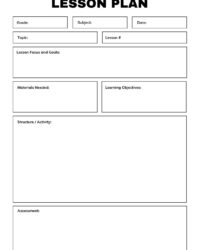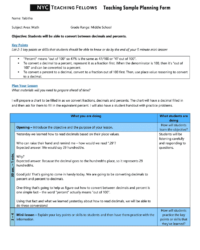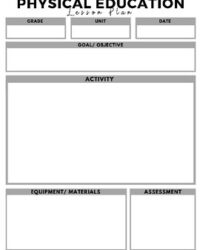Have you ever found yourself standing in front of a classroom, a bit unsure of what to do next? Or perhaps you’re just starting your teaching journey and feel overwhelmed by the sheer number of things to consider for each lesson. Well, you’re not alone! The truth is, effective teaching rarely happens by accident. It’s the result of thoughtful planning, and that’s precisely where understanding the core components of a lesson plan template becomes incredibly valuable.
A well-structured lesson plan acts as your roadmap, guiding you and your students through the learning process with clarity and purpose. It ensures that every minute in the classroom is productive, aligned with learning objectives, and tailored to meet the needs of your diverse learners. Without a solid framework, even the most passionate educators can find themselves adrift. So, let’s dive into what makes up a truly effective lesson plan, helping you to deliver engaging and impactful instruction every single time.
Laying the Groundwork: Essential Preparatory Components
Before you even think about stepping into the classroom, a significant portion of lesson planning involves thoughtful preparation. This initial phase sets the stage for everything that follows, ensuring that your lesson has a clear direction and a strong foundation. It’s about knowing where you’re going, why you’re going there, and what you’ll need along the way. Think of it as the blueprint before construction begins; without a well-defined plan, the structure might just crumble.
Defining Clear Learning Objectives
At the heart of every lesson plan are the learning objectives, sometimes referred to as learning outcomes. These are precise statements that describe what students will know or be able to do by the end of the lesson. They are not merely topics you will cover, but measurable goals for student achievement. For instance, instead of “Students will learn about fractions,” a strong objective might be “Students will be able to identify and name common fractions (e.g., 1/2, 1/3, 1/4) from visual representations.” Well-defined objectives guide your instruction, help you select appropriate activities, and provide a benchmark for assessing student learning. They are the north star of your lesson.
Understanding Your Learners
Another critical preparatory component involves understanding your audience. Who are your students? What are their prior knowledge levels concerning the topic? Are there any specific learning needs or preferences you should consider? This audience analysis helps you tailor your content, activities, and even your language to resonate effectively with your learners. Knowing your students’ backgrounds, interests, and potential challenges allows you to anticipate misconceptions, differentiate instruction, and create a more inclusive and engaging learning environment for everyone. It ensures that the lesson is pitched at the right level, preventing both boredom from being too easy and frustration from being too difficult.
Furthermore, preparation includes outlining the materials and resources required. This might seem straightforward, but forgetting a crucial worksheet, a specific piece of equipment, or access to a particular online tool can derail a lesson entirely. A comprehensive list ensures you have everything at your fingertips, allowing the lesson to flow smoothly without interruptions. This also extends to thinking about the physical setup of the classroom and any technological needs. By meticulously planning these initial components, you create a robust framework that supports effective teaching and maximizes student learning potential.
Bringing the Lesson to Life: Implementation and Reflection
Once the groundwork is meticulously laid, the next phase of a lesson plan focuses on the actual delivery and the crucial step of reflection. This is where your carefully prepared blueprint transforms into a dynamic learning experience within the classroom. It involves outlining the sequence of activities, how you will engage students, and ultimately, how you will assess their understanding and reflect on the lesson’s success.
The implementation section typically details the various stages of the lesson, from the attention-grabbing introduction to the main instructional activities, guided practice, independent work, and finally, a meaningful conclusion. Each stage has a specific purpose, designed to move students progressively towards achieving the learning objectives. It’s not just about listing activities, but also considering the approximate time allocation for each, ensuring a realistic pace that allows for both thorough instruction and student engagement. Think about how you will transition smoothly between activities and maintain student focus throughout.
Crucially, this part of the template also prompts you to consider assessment strategies. How will you check for understanding throughout the lesson, not just at the end? These formative assessments could be quick questions, thumbs-up/thumbs-down, short written responses, or observations of group work. Planning these checks allows you to make real-time adjustments to your instruction if students are struggling or excelling.
Here are the key stages often included in the implementation section:
* Introduction or Hook
* Direct Instruction
* Guided Practice
* Independent Practice
* Assessment (Formative and Summative)
* Closure or Wrap-up
Finally, and often overlooked, is the reflection component. While not always a separate heading within the template you hand in, it’s an essential part of the teaching cycle. After the lesson, taking a moment to consider what went well, what could be improved, and how students responded to the activities is invaluable. This reflective practice helps refine future lessons and contributes significantly to your professional growth as an educator. It’s how you learn from experience and continuously enhance your craft.
Understanding and utilizing all the components of a lesson plan template empowers educators to create structured, purposeful, and engaging learning experiences. It provides a comprehensive guide, ensuring that every minute of instruction is maximized for student growth and achievement. By meticulously planning each element, from objectives to assessment, you build a solid foundation for effective teaching.
Embracing this structured approach to lesson planning ultimately leads to more confident teaching and more successful learning outcomes. It allows for adaptability when needed, as you have a clear understanding of your goals and how to achieve them. Continually refining your approach and reflecting on the impact of your lessons will ensure that your educational endeavors are consistently impactful and enriching for all involved.


